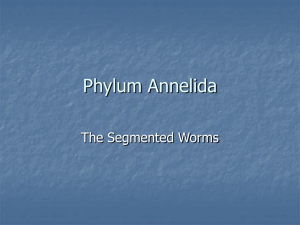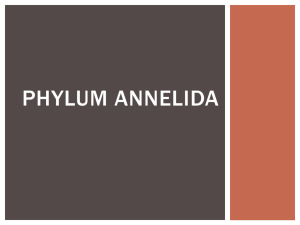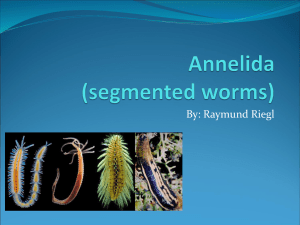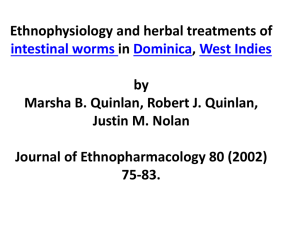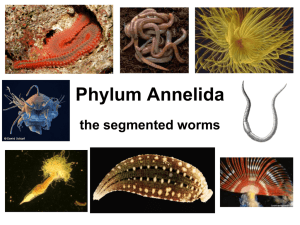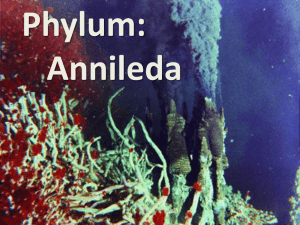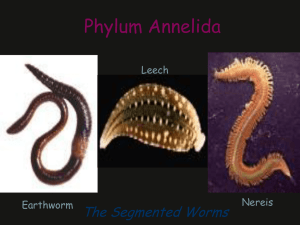ZLY 103 Phylum Annelida
advertisement
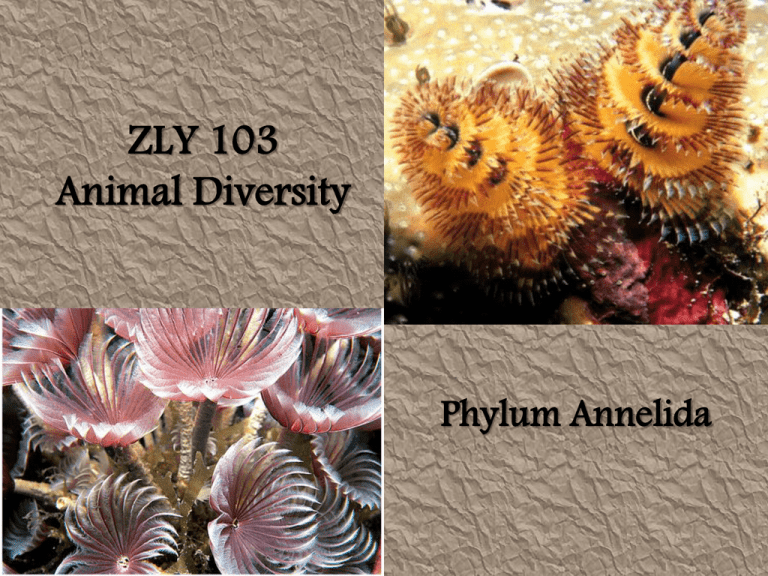
ZLY 103 Animal Diversity Phylum Annelida Introduction Phylum Annelida (an-nel′i-da) (L. annelus, little ring, + ida, pl. suffix) consists of the segmented worms. Annelids are diverse numbering about 15,000 species. The most familiar are earthworms and freshwater worms (class Oligochaeta) and leeches (class Hirudinea). Approximately 2/3rds of Annelids are marine worms (class Polychaeta), (less familiar). Among the latter are many curious members; some are strange, even grotesque, whereas others are graceful and beautiful Introduction They include clamworms, plumed worms, parchment worms, scaleworms, lugworms, and many others. Annelids are true protostome coelomates belonging to super phylum Lophotrochozoa, which exhibit spiral cleavage and mosaic development. Highly developed group with a centralized nervous system and a complex circulatory. Annelids have a spiral cleavage and determinate development. First group to exhibit true metameric segmentation Importance & Biological Contributions Annelids opened a wide complexity and variability in forms and structure, viz:- Metamerism (Segmentation) foundation for specialization Presence of Coelom (fluid filled cavity) between 2 layers: splanchnic & somatic mesoderm respectively Constant body segmentation, structurally and morphologically similar Each metamere components work in unison, segments are interdependent Youngest segment appear at the posterior end and new segments originates from the pygidium Evolutionary importance of Metamerism 1. Advent of greater complexity in form and structure. 2. Specialization in segmentation (Tagmatization). 3. Metamerism brought built-in-redundancy 4. Metamerism opens the door for wide advances in functions as seen in Arthropoda. 5. The evolution of true coelom began with Annelids but came with some consequences: – Total separation of the gut and associated muscles from body wall – Complexity in organization (ends dorsoventral body) – Diffusion no longer solves gaseous exchange and feeding Advantages of Coelomic Inclusion 1. Reproduction: Gonads, gametes shed and mature within the coelomic cavity. 2. Acccomodation: Various organs perform biological functions independently 3. Excretion & Osmoregulation: Coelom serves as temporary storage sites of metabolic wastes. 4. Support, Hydrostatic skeleton & Protection: Coelom offers shape, support and protection to delicate organs. 5. Movement: Body wall movement without effect on the gut. Characteristics They are triploblastic, bilateral, metameric segmented coelomates. • They are externally marked by circular rings called annuli (the name of the phylum refers to this characteristic). • Annelids are sometimes called “bristle worms” because, (except leeches), most annelids bear tiny chitinous bristles called setae. • Short needlelike setae help anchor segments during locomotion and long hair like setae aid aquatic forms in swimming. • The coelom develops embryonically as a split in the mesoderm on each side of the gut (schizocoel). Characteristics • They burrow or live in secreted tubes, stiff setae also aid in preventing the worm from being pulled out of soil. • Habitats – Mostly aquatic: marine or freshwater, – Some terrestrial: Burrow or live in tubes, Sedentary, free-living – Few are parasitic • Organ-system grade of body organization. • Excretory system is the nephridium: Arranged paired on each body segment. • Central Nervous System (CNS) comprised of solid, ventral, double ganglionated nerve cord and paired dorsal cerebral ganglia (Brain). Characteristics • Alimentary system is tube-like, complete, extending from mouth to anus (Open gut system). • Blood system is closed circulatory • Some monoecious: hermaphrodites – Direct development • Dioecious: Unisex – Indirect development • Free-swimming Trocophore larva stage in indirect development (next slide). • Some exhibit asexual reproduction by budding Polychaete Trochophore Larvae Phylum Annelida General Body Plan • ectoderm • mesoderm • endoderm • coelom • septum one metamere l.s. segmented worm Body Cavities Eucoelomates Body cavity completely lined with mesoderm Mesoderm coelom gut Ectoderm Endoderm Basic Body Plan Schizocoel: Split in the mesoderm. Peritoneum: (a layer of mesodermal epithelium) lines the body wall of each compartment, forming dorsal and ventral mesenteries that cover all organs Phylum Annelida Class Polychaeta Class Clitellata Class Aelosomata Aelosomata Marine worms Subclass Errantia Subclass Sedentaria Subclass Oligochaeta earthworms Subclass Hirudinae Leeches Phylogeny of Annelids • Polychaeta is a paraphyletic class because ancestors of the clitellates arose from within it. • Oligochaeta and Hirudinea form a monophyletic group called Clitellata. – Characterized by reproductive structure called a clitellum. • Class Oligochaeta is a paraphyletic group because ancestors of leeches arose from within it. Cladogram showing Phylogeny Class Polychaeta Gr. polys, many, + chaite, long hair – Distinct head with eyes and tentacles (Distinct) – Most segments with parapodia with tufts of setae. – Cirri/branchiae for respiration. – Clitellum absent – Usually dioecious – Examples: Nereis Subclass Sedentaria •Fan worms, •Christmas-tree worms •Spaghetti worms •Chaetopterus •Lug worms Subclass Errantia • Sand worms, • Scale worms • Fire worms • palolo worms Class Polychaeta • Most have parapodia and gills for gaseous exchange. – Others use the body surface. • Circulation varies. – In Nereis a dorsal vessel carries blood forward and a ventral vessel carries blood posteriorly. – Blood flows across between these major vessels in networks around the parapodia and intestine. • In some, septa are incomplete and coelomic fluid serves circulatory function. • Many polychaetes have respiratory pigments Hemoglobin, chlorocruorin or hemerythrin. Class Polychaeta • Largest group of annelids • Primarily marine (Most are benthic, but some live pelagic lives in the open seas). • Most segments include a pair of paddle–like parapodia. • Often tube-dwelling (secrete mucus/CO3 • Fertilization is external with free-swimming larva Sub-class of Polychaeta Feather duster worm (Sedentaria) Christmas tree worm (Sedentaria) Sphagethi worm (Sedentaria) Chaeopteris (Sedentaria) Lugworm (Sedentaria) Sub-class of Polychaeta Scale worm (Errantia) Scale worm (Errantia) Lugworm (Sedentaria) Fire worm (Errantia) Biology of Nereis diversicolor • It lives in U – shaped burrows where it emerges on to the surface and extending its anterior portion to capture prey. • They are predatory in habit • The body is externally and internally divided into 100 segments. • The parapodia are rich in blood supply and used in respiration as well as locomotion. • Has considerable power of regeneration • Fertilization is external. • Closed circulatory system and excretes mainly ammonia through the nephridia Lugworm in burrow Chart showing muscular eversible pharynx Retracted Pharynx Everted Pharynx The pharynx is everted by contraction of body wall muscles. Chart showing Cirri & Chaetae Class Oligochaeta (Earthworm) General characteristics: • few setae per segment • term “earthworm” is academically incorrect because aquatic & parasitic forms are included • most are monoecious, cross-fertilization • most highly organized animals to have regeneration • clitellum (secretes cocoon) Aquatic Earthworms Subclass Oligochaeta Gk: Oligos, few; chaetae; bristles • Lack parapodia and have few setae • Lack the distinctive head region of polychaetes and have no eyes. • Scavengers that consume soil that contains organic matter • The ingested soil moves into a storage chamber called the crop, then to an area called the gizzard, where grinding action breaks down the soil particles. Undigested material passes out the anus in a form called castings, which are prized as soil fertilizer. Biology of Libyodrilus • West Africa eudrilid earthworm inhabiting all soil types except dry and acidic soils. • They prefer soils rich in organic matters. • Rainy season favours distribution. • The body is long, pointed (120-125 segments) corresponding exactly to the number of internal septa. • First and last segment different from other body segments. • 1st segment is called the peristomium, 125th segments called pygidium. • All segments secrete mucus, albumen etc. necessary for cocoon formation. Biology of Libyodrilus The body of Libyodrilus is divided as follows: Pre-clitellum region: Anterior part lying between 1st and 13th segment. Clitellum region: Segment 14th to 17th. Post-clitellum region: Remaining body part after the clitellum from 18th to 125th. Reproduction • Occurs throughout the year but copulation takes place at night when there is warmth and increase moisture. • Fertilization is internal within the cocoon. • Direct development, no larvae. • Young worms lack clitellum. Sexual Reproduction in Earthworm Economic Importance of Earthworms • They improve soil fertility when burrowing and feeding thus enhancing aeration, porosity and exhuming rich soil. • They increase the organic content of the soil by dragging plant materials into their burrows. • They are used as bait for catching fishes • Some communities feed on earthworms • They are used for the manufacture of drugs. Economic Importance of Earthworms Harmful Effects • They destroy young plants by scavenging. • Some are secondary host for the completion of life stages of certain parasites. • They aid soil erosion. Aporrectodea turgida Earthworm Morphology Guide Morphology -Number & location of GTs and TPs, -location & shape of clitellum Ecology Location of burrows L. rubellus Common Terrestrial Oligocheates: Earthworms • • • • • • • • Octagonal-tail worm (Dendrobaena octaedra) Red marsh worm (Lumbricus rubellus) Dew-worm or night crawler (Lumbricus terrestris) Pink soil worm (Aporrectodea rosea) Canadian worm (Aporrectodea tuberculata) Pasture worm (Aporrectodea turgida) Woodland white worm (Octolasion tyrtaeum) Red worm (Eisenia fetida ) Class Hirudinea General Characteristics: • mostly fluid feeders • fresh & marine • possess clitellum – apparent only during reproduction • have annelid characteristics but lack setae • true bloodsuckers have cutting plates for cutting through tissue of the host organism • usually attaches by posterior sucker until suitable spot is found for attachment of anterior sucker • salivary glands secrete anticoagulant called hirudin that prevents clotting. • Microsurgeons engage medicinalis to reconnect arteries Class Hirudinea • Excretion by metanephridia • Swimming by vertical undulations or loops by using its suckers to grip surfaces. • They exhibit variation in patterns and colours. • They are dorso-ventrally flattened. • Most leeches are ectoparasites (haematophagus, sanguivorous). • Some are predacious with suckers for anchorage. • The gut is adapted for storage of large quantities of blood. • Mouth opens at the base of the anterior sucker, has 3 halfmoon-shaped jaws. Class Hirudinea • Hermaphroditic, possessing temporary clitellum (only during breeding). • The clitellum secretes cocoon for reception and storage of eggs. • No asexual reproduction and no power of regeneration. Class Hirudinea • Biology Thanks for Listening
